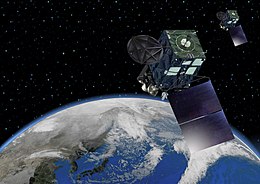 Rendering of Himawari 8 and 9 | |
| Mission type | Weather satellite |
|---|---|
| Operator | JMA |
| COSPAR ID | 2016-064A [1] |
| SATCAT no. | 41836 |
| Mission duration | 8 years (planned) |
| Spacecraft properties | |
| Bus | DS2000 |
| Manufacturer | Mitsubishi Electric |
| Launch mass | 3500 kg |
| Dry mass | 1300 kg |
| Power | 2.6 kilowatts from solar array |
| Start of mission | |
| Launch date | 06:20,2 November 2016(UTC) |
| Rocket | H-IIA 202 |
| Launch site | Tanegashima LA-Y1 |
| Contractor | Mitsubishi Heavy Industries |
| Entered service | 05:00,13 December 2022(UTC) |
| Orbital parameters | |
| Reference system | Geocentric |
| Regime | Geostationary |
| Longitude | 140.7° East |
| Epoch | Planned |
Himawari 9 is a Japanese weather satellite, the 9th of the Himawari geostationary weather satellite operated by the Japan Meteorological Agency. The spacecraft was constructed by Mitsubishi Electric, and is the second of two similar satellites to be based on the DS-2000 bus. [2]

